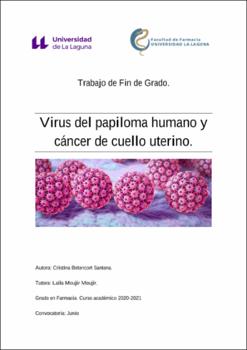Virus del papiloma humano y cáncer de cuello uterino
Author
Betancort Santana, CristinaDate
2021Abstract
La infección por el virus del papiloma humano (VPH) es la infección de transmisión
sexual más frecuente. Afecta principalmente a mujeres y hombres jóvenes. La
importancia recae principalmente en las mujeres por el posible desarrollo de cáncer de
cérvix por los VPH 16 y 18 de alto riesgo oncogénico, que además producen neoplasias
en ano y orofaringe. Estos virus para lograr una replicación viral eficiente alteran muchas
vías de señalización celular mediante la expresión de proteínas específicas. Esto conduce
a una inestabilidad genómica, que se traduce en la transformación celular. Actualmente,
existen 3 vacunas profilácticas contra el VPH que ofrecen una protección eficaz y segura,
sin embargo, son costosas y no protegen contra todos los tipos.
El objetivo de este trabajo es realizar una revisión bibliográfica acerca de los aspectos
más importantes de este virus haciendo especial hincapié en su papel en el desarrollo de
neoplasias malignas y en especial en el cáncer de cuello uterino (CaCu), así como las
actuales estrategias de prevención. Human papillomavirus (HPV) infection is the most common sexually transmitted
infection. It mainly affects young women and men. The mostly falls on women due to the
possible development of cervical cancer by reason of HPV 16 and 18 of high oncogenic
risk, which also produce neoplasms in the anus and oropharynx. These viruses to achieve
efficient viral replication, these viruses many cell signaling pathways through the
expression of specific proteins. This leads to genomic instability, which results in cell
transformation. Currently, there are 3 prophylactic HPV vaccines that offer effective and
safe protection, however, they are expensive and do not protect against all types.
The objective of this work is to carry out a bibliographic review about the most important
aspects of this virus with special emphasis on its role in the development of malignant
neoplasms and especially in cervical cancer (CaCu), as well as the current strategies of
prevention.





